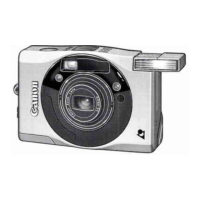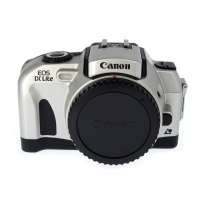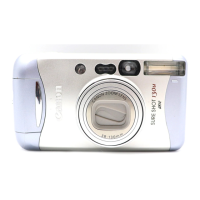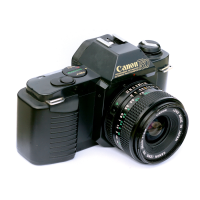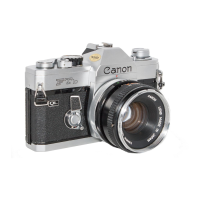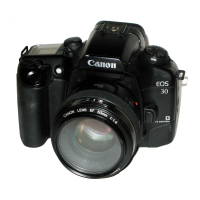Do you have a question about the Canon IXUS Z50 and is the answer not in the manual?
Camera is not water-resistant; store in a cool, dry, dust-free place away from direct sunlight.
Do not disassemble; battery hazards include explosion, burns, and fire.
Use blower brush for cleaning, avoid fluids, and develop exposed film promptly.
Device complies with FCC Rules Part 15 and CE mark requirements.
Explains the division of the manual into four sections: Introduction, Basic Operations, Advanced Operations, and Additional Information.
Explains symbols used for warnings and additional information.
Step-by-step guide to loading the battery into the camera.
Instructions for loading the film cartridge, including checking the indicator.
How to switch the camera on/off and check battery level.
How to select print types and use the zoom function.
Quick overview of simple film loading and the three print types (C, H, P).
Explanation of data (date, title, print type, etc.) recorded magnetically on the film surface.
Process of developing exposed cartridges at certified shops and ordering reprints.
Details on the new film loading process without opening the back cover.
Choice of three print types: Classic, Wide-angle, Panorama.
Information about IX data and getting prints from shops.
Step-by-step guide to loading the battery.
How to open compartment, insert cartridge, and close.
How to turn the camera on, opening the lens cover.
How to select the desired print type via the viewfinder screen.
Using the zoom button to adjust subject size.
Positioning AF frame over subject and taking the picture.
Procedure for removing the film cartridge after it has rewound.
Labels and descriptions of camera parts on the front, like lens, flash, shutter button.
Identification of controls and indicators on the top and rear of the camera.
Detailed explanation of various buttons like Main switch, Flash mode, DATE, SELECT, SET.
Explanation of symbols and information displayed on the LCD panel.
Description of different frames (Picture, AF, Close-up) visible in the viewfinder.
How to use the lever to select C, H, or P print types.
Instructions on how to attach the camera strap securely.
How to use the projection to press various buttons like SELECT, SET, etc.
How to hold the camera to avoid obscuring the image or lens.
Warning about dust or soiling on AF emitter/sensor or lens causing focusing issues.
Steps to open cover, insert battery, and check icon.
Closing the cover and initial date/time display.
How to open compartment, insert cartridge, and close.
Verification that the frame counter shows "1" after loading.
Specifies using IX240 film and the visual exposure indicator.
How to view film type and available shots on the LCD panel.
How to switch the camera on and off, and the lens cover action.
How to interpret the battery icon on the LCD panel.
How to use the print type selection lever to choose print formats.
How viewfinder display changes and what areas are photographed for each print type.
Using the zoom button for wide-angle and telephoto shots.
How pressing the button zooms in or out and the auto-retract feature.
Positioning AF frame and pressing shutter button halfway to set focus.
Holding the shutter button down fully to release the shutter.
Explains the delay between pressing the button and shutter release.
Using CF1 for instant shutter release.
Lit means camera ready; blinks for proximity warning.
Lit means flash fully charged; blinks for camera shake warning.
Table showing warning ranges for C/H and P film types.
How to shoot through a window to avoid focusing on the glass.
How the viewfinder area differs from the photographed area for close-ups.
Using the close-up AF frame and taking the picture.
Confirming the rewind icon blinks before opening the compartment.
Opening compartment, removing cartridge, and checking indicator.
Procedure to remove the cartridge before film end.
Details on processing at APS certified shops, including index prints.
Storing index prints, film cartridges, and avoiding magnetic fields.
How to cycle through flash modes using the button.
Flash fires automatically in low-light.
Reduces red-eye effect in low-light portraits.
Flash fires always or never, respectively.
Combines slow shutter speed and flash for night/sunset scenes.
For non-people subjects or people without red-eye reduction.
Table showing flash range for different film speeds and zoom settings.
How to set the mode to activate the red-eye reduction lamp.
Effective range for lamp and subject must look at camera.
Slow press of shutter button, delayed release.
Explanation of red-eye caused by flash reflecting off the retina.
Red-eye reduction lamp contracts pupils before flash fires.
Tips on subject attention, distance, and ambient light for effectiveness.
Flash fires regardless of light conditions, useful for fill-in flash.
How to select the forced flash mode using the button.
Flash does not fire, useful for sunset or low-light photography.
How to select the suppressed flash mode using the button.
Caution about slow shutter speed and using a tripod.
Combines slow shutter speed and flash for night/sunset backgrounds.
How to select the slow-synchro mode with specific icons.
Importance of tripod use and ensuring subject stillness.
How to lock focus on a subject not in the center.
Composing the shot while maintaining focus.
Warning to re-lock focus if the subject distance changes.
How to activate the self-timer and the icon display.
Taking the picture after the self-timer countdown.
Information on countdown, red-eye reduction, and tripod use.
How to choose between date only, date+time (both sides/back).
Details on displayed vs imprinted data, and photo shop variations.
How to cycle through date formats using DATE and SET buttons.
The selected format is retained after battery replacement.
Steps to display date and sequentially change year, month, day.
Steps to display time and sequentially change hour, minute, second.
Behavior on battery replacement and continuous change.
How to select the language for title imprinting.
How to turn off the title imprinting function.
How to select a specific title from the available list.
Lists titles in Japanese, German, French, Italian, Spanish.
How to specify the number of prints (P-1 to P-9) for the next shot.
After shooting, print quantity reverts to default.
How to specify quantity for the previous frame.
Finalizing the setting and checking date/time display.
How to access custom function settings (CF1, CF2, CF3).
How to navigate between CF1, CF2, and CF3.
How to change the setting for a selected custom function to 1 (On) or 0 (Off).
Explains Realtime Release, Flash Mode Memory, and Automatic Film Rewind.
Positioning AF frame and pressing shutter halfway.
Pressing shutter button fully for immediate release.
Conditions where realtime release does not operate or requires specific modes.
Solutions for battery issues and icon display problems.
Reasons and remedies for shutter unresponsiveness.
Solutions for unexpected sounds or camera not setting to Auto flash.
Troubleshooting for film rewinding and blurred images.
Further causes and solutions for blurred images and 'H' error display.
Solution for when the film compartment fails to open after rewinding.
Answers on using conventional 135mm and slide film.
Explanation of ISO sensitivity and why date doesn't appear on index prints.
Conversion of camera's zoom range to 35mm equivalent.
Details on type, image size, lens, focusing, shutter, viewfinder.
Explanation of indicator meanings and film loading features.
Self-timer duration and metering ranges for different flash modes.
Flash range, recycling time, and description of flash modes.
Details on imprinted data, clock function, and character types.
List of custom functions and battery type used.
Approximate shots per cartridge and camera dimensions/weight.
Camera is not water-resistant; store in a cool, dry, dust-free place away from direct sunlight.
Do not disassemble; battery hazards include explosion, burns, and fire.
Use blower brush for cleaning, avoid fluids, and develop exposed film promptly.
Device complies with FCC Rules Part 15 and CE mark requirements.
Explains the division of the manual into four sections: Introduction, Basic Operations, Advanced Operations, and Additional Information.
Explains symbols used for warnings and additional information.
Step-by-step guide to loading the battery into the camera.
Instructions for loading the film cartridge, including checking the indicator.
How to switch the camera on/off and check battery level.
How to select print types and use the zoom function.
Quick overview of simple film loading and the three print types (C, H, P).
Explanation of data (date, title, print type, etc.) recorded magnetically on the film surface.
Process of developing exposed cartridges at certified shops and ordering reprints.
Details on the new film loading process without opening the back cover.
Choice of three print types: Classic, Wide-angle, Panorama.
Information about IX data and getting prints from shops.
Step-by-step guide to loading the battery.
How to open compartment, insert cartridge, and close.
How to turn the camera on, opening the lens cover.
How to select the desired print type via the viewfinder screen.
Using the zoom button to adjust subject size.
Positioning AF frame over subject and taking the picture.
Procedure for removing the film cartridge after it has rewound.
Labels and descriptions of camera parts on the front, like lens, flash, shutter button.
Identification of controls and indicators on the top and rear of the camera.
Detailed explanation of various buttons like Main switch, Flash mode, DATE, SELECT, SET.
Explanation of symbols and information displayed on the LCD panel.
Description of different frames (Picture, AF, Close-up) visible in the viewfinder.
How to use the lever to select C, H, or P print types.
Instructions on how to attach the camera strap securely.
How to use the projection to press various buttons like SELECT, SET, etc.
How to hold the camera to avoid obscuring the image or lens.
Warning about dust or soiling on AF emitter/sensor or lens causing focusing issues.
Steps to open cover, insert battery, and check icon.
Closing the cover and initial date/time display.
How to open compartment, insert cartridge, and close.
Verification that the frame counter shows "1" after loading.
Specifies using IX240 film and the visual exposure indicator.
How to view film type and available shots on the LCD panel.
How to switch the camera on and off, and the lens cover action.
How to interpret the battery icon on the LCD panel.
How to use the print type selection lever to choose print formats.
How viewfinder display changes and what areas are photographed for each print type.
Using the zoom button for wide-angle and telephoto shots.
How pressing the button zooms in or out and the auto-retract feature.
Positioning AF frame and pressing shutter button halfway to set focus.
Holding the shutter button down fully to release the shutter.
Explains the delay between pressing the button and shutter release.
Using CF1 for instant shutter release.
Lit means camera ready; blinks for proximity warning.
Lit means flash fully charged; blinks for camera shake warning.
Table showing warning ranges for C/H and P film types.
How to shoot through a window to avoid focusing on the glass.
How the viewfinder area differs from the photographed area for close-ups.
Using the close-up AF frame and taking the picture.
Confirming the rewind icon blinks before opening the compartment.
Opening compartment, removing cartridge, and checking indicator.
Procedure to remove the cartridge before film end.
Details on processing at APS certified shops, including index prints.
Storing index prints, film cartridges, and avoiding magnetic fields.
How to cycle through flash modes using the button.
Flash fires automatically in low-light.
Reduces red-eye effect in low-light portraits.
Flash fires always or never, respectively.
Combines slow shutter speed and flash for night/sunset scenes.
For non-people subjects or people without red-eye reduction.
Table showing flash range for different film speeds and zoom settings.
How to set the mode to activate the red-eye reduction lamp.
Effective range for lamp and subject must look at camera.
Slow press of shutter button, delayed release.
Explanation of red-eye caused by flash reflecting off the retina.
Red-eye reduction lamp contracts pupils before flash fires.
Tips on subject attention, distance, and ambient light for effectiveness.
Flash fires regardless of light conditions, useful for fill-in flash.
How to select the forced flash mode using the button.
Flash does not fire, useful for sunset or low-light photography.
How to select the suppressed flash mode using the button.
Caution about slow shutter speed and using a tripod.
Combines slow shutter speed and flash for night/sunset backgrounds.
How to select the slow-synchro mode with specific icons.
Importance of tripod use and ensuring subject stillness.
How to lock focus on a subject not in the center.
Composing the shot while maintaining focus.
Warning to re-lock focus if the subject distance changes.
How to activate the self-timer and the icon display.
Taking the picture after the self-timer countdown.
Information on countdown, red-eye reduction, and tripod use.
How to choose between date only, date+time (both sides/back).
Details on displayed vs imprinted data, and photo shop variations.
How to cycle through date formats using DATE and SET buttons.
The selected format is retained after battery replacement.
Steps to display date and sequentially change year, month, day.
Steps to display time and sequentially change hour, minute, second.
Behavior on battery replacement and continuous change.
How to select the language for title imprinting.
How to turn off the title imprinting function.
How to select a specific title from the available list.
Lists titles in Japanese, German, French, Italian, Spanish.
How to specify the number of prints (P-1 to P-9) for the next shot.
After shooting, print quantity reverts to default.
How to specify quantity for the previous frame.
Finalizing the setting and checking date/time display.
How to access custom function settings (CF1, CF2, CF3).
How to navigate between CF1, CF2, and CF3.
How to change the setting for a selected custom function to 1 (On) or 0 (Off).
Explains Realtime Release, Flash Mode Memory, and Automatic Film Rewind.
Positioning AF frame and pressing shutter halfway.
Pressing shutter button fully for immediate release.
Conditions where realtime release does not operate or requires specific modes.
Solutions for battery issues and icon display problems.
Reasons and remedies for shutter unresponsiveness.
Solutions for unexpected sounds or camera not setting to Auto flash.
Troubleshooting for film rewinding and blurred images.
Further causes and solutions for blurred images and 'H' error display.
Solution for when the film compartment fails to open after rewinding.
Answers on using conventional 135mm and slide film.
Explanation of ISO sensitivity and why date doesn't appear on index prints.
Conversion of camera's zoom range to 35mm equivalent.
Details on type, image size, lens, focusing, shutter, viewfinder.
Explanation of indicator meanings and film loading features.
Self-timer duration and metering ranges for different flash modes.
Flash range, recycling time, and description of flash modes.
Details on imprinted data, clock function, and character types.
List of custom functions and battery type used.
Approximate shots per cartridge and camera dimensions/weight.
| Brand | Canon |
|---|---|
| Model | IXUS Z50 |
| Category | Film Camera |
| Language | English |
